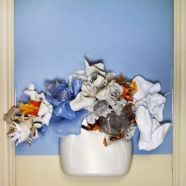
A Day in the Life, 2016. Melted and formed plastic household recyclables, and resin on panel.
Share This
Print This
Email This
Portfolio: Recyclable Materials
- Hot House Horticulture, 2013. Melted and formed plastic recyclables, found frame, resin on board.
- Broken Promises, 2013. Melted and formed plastic recyclables, resin, and steel.
- Brings May Flowers, 2013, 2015. One month’s household melted plastic recyclables, resin, and found frame.
- Red Cup Still Life, 2014. Melted and formed plastic recyclables, resin, and steel.
- Deluge, 2014. Melted and formed melted plastic recyclables, steel, ceramic bucket on wood pedestal.
- Pseudo Bottle Still Life, 2014. Melted and formed plastic recyclables, resin, steel, and plastic vase.
My work presents definitive relationships across material, form, and subject matter with ties to feminist issues. I view my work as typifying the underrepresented, discarded, disregarded, and domestic by showing relationships between the historical and the contemporary and alluding to the destructive and absurd patterns of human behavior. All too often, these patterns and policies are the result of the few prevailing over the many with little regard for the interests of the many.
After spending time reflecting on personal experiences and identifying subjects that were important to me, I realized that the parallel universes of motherhood, artist, contractor, and feminist merge together in my work in a manner that makes larger public social context collide with more private domesticity. After working as a gallery director in Boston, a design/build contractor, and becoming a mother of two daughters, I felt compelled to begin using materials from the home that are often overlooked or discarded as starting points for my work. By using silk flowers, crochet, zip ties, and even plastic recyclables, I aim to question “high art” materials and the value ascribed to everyday objects, while trying to blur the distinctions between art and craft. Making my artist’s mark with these materials also embraces the positive aspects of women’s history as makers and references the domestic sphere.
With this particular body of work I gathered one month of recyclables from our family’s household bin and manipulated them into floral forms that I composed in the tradition of the still lifes of the Dutch Masters. I wanted to use materials taken from the home to emphasize our consumeristic tendencies and the accumulation of waste. My objective was to skillfully transform the material so that it conceals its origin initially, but then reveals itself upon closer investigation.
Just as seventeenth-century Dutch floral paintings were produced in such numbers that they were an inexpensive alternative to the costly masterpieces brought on by the burgeoning bulb industry, my contemporary plastic arrangements could serve as the alternative to the disappearing landscape caused by climate change and the overindulgences of an excessive society. As nature and resources become scarcer, one has to consider documentation as evidence of what came before. These works suggest a link between the present and something past that has been “passed down” to the next generation. The historical context, material selection, and the use of the flower are combined with an intention to provoke a sense of irony in the viewer’s response.







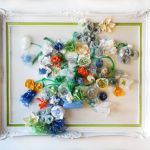
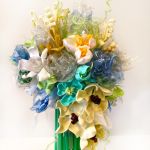
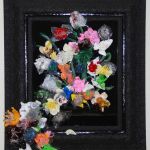
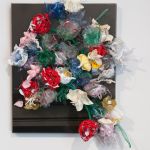
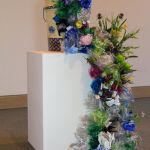
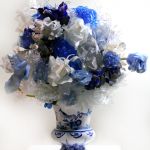
Such an elegantly conceived and executed body of work! I appreciate the serious intent at the same time find myself smiling with delight at the wit and weird beauty of these objects.
Thank you Elizabeth! I love that you found the irony in the work. I find that humor and absurdity often opens more people up to a serious dialogue than having to hit them over the head with a “sledge hammer” of a message.
What an elegantly conceived and executed body of work!
While I appreciate the serious intent, the wit and weird beauty of these pieces really delight me.